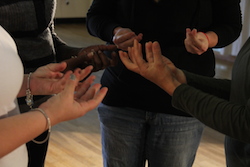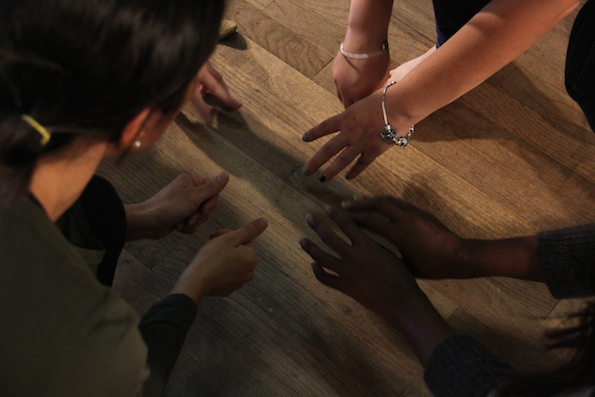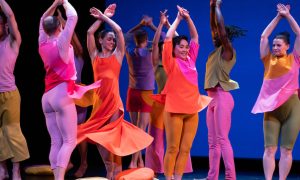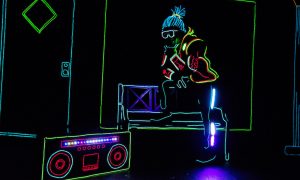By Katherine Moore of Dance Informa.
In some communities, it’s only the lucky few who get to experience the power of dance. While professional dancers and students might be able to experience self-expression and a sense of community through movement on a daily basis, it often takes a visionary organization such as CORE to promote these experiences in communities that traditionally do not have access to dance.
Dually-based in both Houston and Atlanta, the 30-year old organization is home to the CORE Performing Company and a vast array of presenting, education, and community outreach programs for artists and students alike. Notable among these programs is Dynamic X-Change.
First piloted in 1994, Dynamic X-change is an outreach program that uses movement to connect with socially-isolated populations. Overseeing this program is Joy Peace, the head of Outreach and Education for CORE. Ms. Peace asserts that Dynamic X- Change’s strength stems from its malleability and capacity to serve unique populations with different needs. With current and past programs serving at-risk youth, the elderly, homeless women and children, and others, Dynamic X-Change seeks to offer healing through the transformative power of movement.
“We’re coming into this space together, and we don’t know what outcome will be. It’s truly a collaborative idea of embracing specific populations,” Ms. Peace says.
All Dynamic X-Change programs are lead by teaching artists who have been trained through the Teachers Training Institute (TTI), a professional development opportunity piloted by CORE in 2006 and created in collaboration with Atlanta Ballet, Dance Educators of Georgia and Moving in the Spirit. Artistic Director of CORE is Sue Schroeder, a founding member of TTI who piloted the Dynamic X-Change programs.

Participants experiment with rocks through CORE’s Dynamic X-Change Program. Photo by Patricia Mastrovito.
Dynamic X-Change teaching artists are trained to target their program lessons to the specific needs of their populations, so the nature of the work with participants can vary among creative exercises, centering/breathing techniques, physical fitness, and more.
Ms. Peace explains, “It’s not in any way a dance class. They are not learning steps that they are trying to remember. It’s a process.”
For example, at Monarch School, where students are facing neurological disorders that challenge their ability to connect and stay in tune with other people, Dynamic X-Change is leading them through a flashmob-like format to practice staying present without feeling overwhelmed.
“These kids have the opportunity to practice eye contact, physical touch, and create dances they show to each other in a safe environment,” Ms. Peace says.
On the other side of the spectrum is Dynamic X-Change’s program run through Breakthru house, a holistic residential treatment program for women recovering from addiction.
Ms. Peace says, “These women have a great deal of healing to do. They’ve lost everything and have suffered a great deal of abuse, either self-inflicted or otherwise. So in our program we explore issues of self-worth and self-esteem, and eventually these women start to have positive experiences in their body again.”
Consequently, the nature of the program at Breakthru looks entirely different than that at Monarch School. For example, teaching artist Jauna Farfan brought in many different types of rocks, varying in texture, size, and weight, and used them as tools throughout the class for participants to experiment with.
Ms. Peace explains, “Juana would use these rocks as her vehicle. She asked the women to select a rock and then assign to it an aspect of themselves that was heavy and weighing them down. Then they experienced moving through space with the rock, feeling the weight and the aspect of themselves that was heavy with their feet, with their elbows, on their shoulders, trying to balance the challenge of holding on and then experience the freedom of letting it go.”

CORE’s Dynamic X-Change Program. Photo by Patricia Mastrovito.
When asked why she believes movement is such a powerful method of healing, Peace claims that it gives a tool for expression when words might fail.
Peace says, “When we physicalize things that are still in some way abstract in our awareness, things that may seem elusive, it brings it into a physical form that we can express in a deeper level. Movement comes from a different place than the analytical place of journal writing. Movement reaches you on a cellular level.”
An organization deeply rooted in collaboration in all levels of its programming, CORE is constantly looking for partnering organizations to expand their community efforts. With two home cities already, Ms. Peace’s goal is to grow Dynamic X-Change nationally.
“This is outreach that could go anywhere,” she says. “It’s about the teacher training that we do. Once someone is really trained in this intentional way and knows how to access whichever population they are serving at the time, that is all that is required.”
On a smaller, more personal scale, Ms. Peace, who is also a dancer and choreographer in her work outside of CORE, connects what happens through Dynamic X-change with her work in the dance studio and onstage.
She says, “I am very deeply impassioned about this work because it gets to the core of real people, addressing real issues and real lives in a real way, in an honest, non-dancer approach. They have no dance training, so to see average every day human beings express themselves via movement, it gives so much information about a genuine movement vocabulary… It informs even what I ask of my dancers in my own work, and how I access what I want to do with them and explore.”
To find out more about CORE Performance Company and Dynamic X-Change visit www.coredance.org.
Photo (top): CORE’s X-Change Program. Photo by Patricia Mastrovito.















